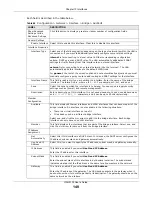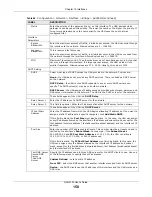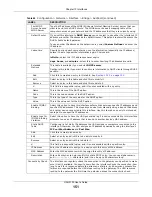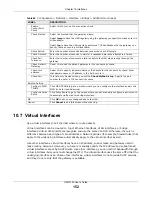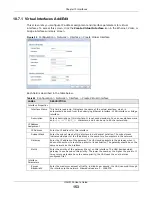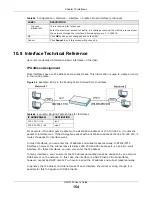
Chapter 10 Interfaces
UAG5100 User’s Guide
139
• Traffic inside each VLAN is layer-2 communication (data link layer, MAC addresses). It is handled
by the switches. As a result, the new switch is required to handle traffic inside VLAN 2. Traffic is
only broadcast inside each VLAN, not each physical network.
• Traffic between VLANs (or between a VLAN and another type of network) is layer-3
communication (network layer, IP addresses). It is handled by the router.
This approach provides a few advantages.
• Increased performance - In VLAN 2, the extra switch should route traffic inside the sales
department faster than the router does. In addition, broadcasts are limited to smaller, more
logical groups of users.
• Higher security - If each computer has a separate physical connection to the switch, then
broadcast traffic in each VLAN is never sent to computers in another VLAN.
• Better manageability - You can align network policies more appropriately for users. For example,
you can set different bandwidth limits for each VLAN (each department in the example above).
These rules are also independent of the physical network, so you can change the physical
network without changing policies.
In this example, the new switch handles the following types of traffic:
• Inside VLAN 2.
• Between the router and VLAN 1.
• Between the router and VLAN 2.
• Between the router and VLAN 3.
VLAN Interfaces Overview
In the UAG, each VLAN is called a VLAN interface. As a router, the UAG routes traffic between VLAN
interfaces, but it does not route traffic within a VLAN interface. All traffic for each VLAN interface
can go through only one Ethernet interface, though each Ethernet interface can have one or more
VLAN interfaces.
Note: Each VLAN interface is created on top of only one Ethernet interface.
Otherwise, VLAN interfaces are similar to other interfaces in many ways. They have an IP address,
subnet mask, and gateway used to make routing decisions. They restrict bandwidth and packet
size. They can provide DHCP services, and they can verify the gateway is available.
10.5.1 VLAN Interface Summary Screen
This screen lists every VLAN interface and virtual interface created on top of VLAN interfaces. To
access this screen, click Configuration > Network > Interface > VLAN.

























